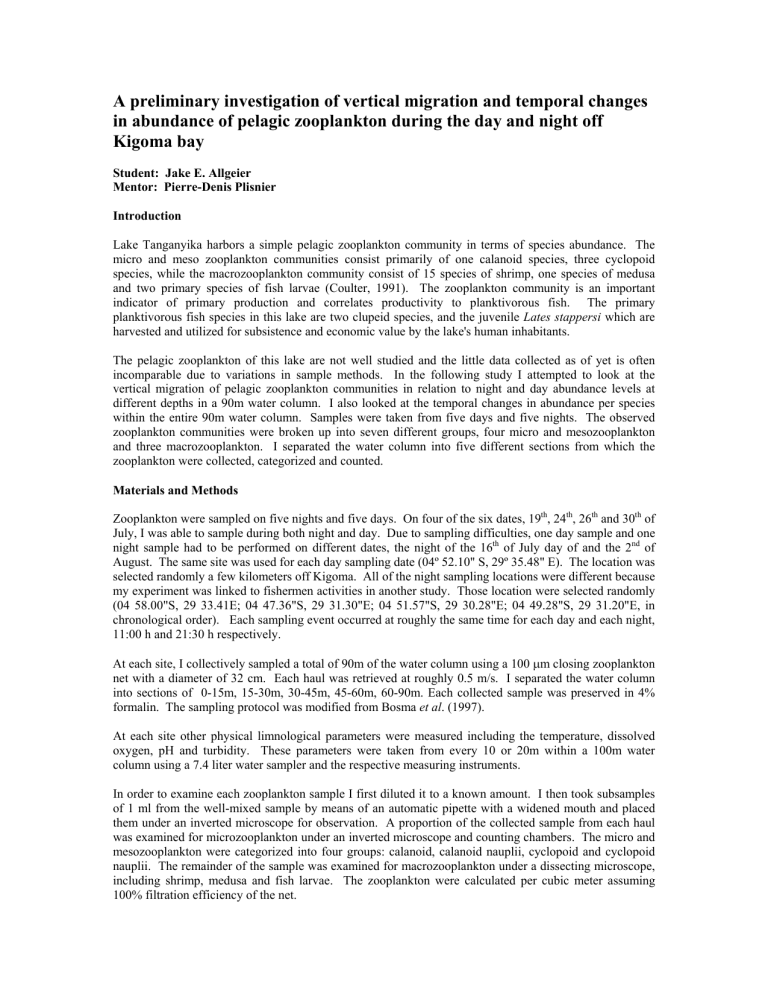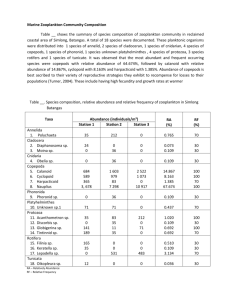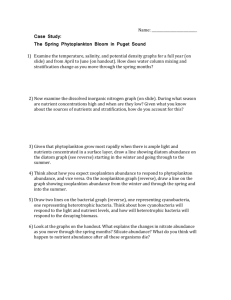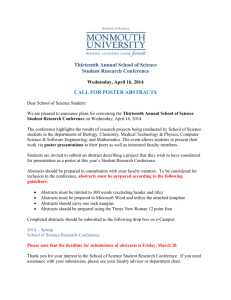A preliminary investigation of vertical migration and temporal changes

A preliminary investigation of vertical migration and temporal changes in abundance of pelagic zooplankton during the day and night off
Kigoma bay
Student: Jake E. Allgeier
Mentor: Pierre-Denis Plisnier
Introduction
Lake Tanganyika harbors a simple pelagic zooplankton community in terms of species abundance. The micro and meso zooplankton communities consist primarily of one calanoid species, three cyclopoid species, while the macrozooplankton community consist of 15 species of shrimp, one species of medusa and two primary species of fish larvae (Coulter, 1991). The zooplankton community is an important indicator of primary production and correlates productivity to planktivorous fish. The primary planktivorous fish species in this lake are two clupeid species, and the juvenile Lates stappersi which are harvested and utilized for subsistence and economic value by the lake's human inhabitants.
The pelagic zooplankton of this lake are not well studied and the little data collected as of yet is often incomparable due to variations in sample methods. In the following study I attempted to look at the vertical migration of pelagic zooplankton communities in relation to night and day abundance levels at different depths in a 90m water column. I also looked at the temporal changes in abundance per species within the entire 90m water column. Samples were taken from five days and five nights. The observed zooplankton communities were broken up into seven different groups, four micro and mesozooplankton and three macrozooplankton. I separated the water column into five different sections from which the zooplankton were collected, categorized and counted.
Materials and Methods
Zooplankton were sampled on five nights and five days. On four of the six dates, 19 th , 24 th , 26 th and 30 th night sample had to be performed on different dates, the night of the 16 th of July day of and the 2 nd
of
July, I was able to sample during both night and day. Due to sampling difficulties, one day sample and one
of
August. The same site was used for each day sampling date (04º 52.10" S, 29º 35.48" E). The location was selected randomly a few kilometers off Kigoma. All of the night sampling locations were different because my experiment was linked to fishermen activities in another study. Those location were selected randomly
(04 58.00"S, 29 33.41E; 04 47.36"S, 29 31.30"E; 04 51.57"S, 29 30.28"E; 04 49.28"S, 29 31.20"E, in chronological order). Each sampling event occurred at roughly the same time for each day and each night,
11:00 h and 21:30 h respectively.
At each site, I collectively sampled a total of 90m of the water column using a 100 µ m closing zooplankton net with a diameter of 32 cm. Each haul was retrieved at roughly 0.5 m/s. I separated the water column into sections of 0-15m, 15-30m, 30-45m, 45-60m, 60-90m. Each collected sample was preserved in 4% formalin. The sampling protocol was modified from Bosma et al . (1997).
At each site other physical limnological parameters were measured including the temperature, dissolved oxygen, pH and turbidity. These parameters were taken from every 10 or 20m within a 100m water column using a 7.4 liter water sampler and the respective measuring instruments.
In order to examine each zooplankton sample I first diluted it to a known amount. I then took subsamples of 1 ml from the well-mixed sample by means of an automatic pipette with a widened mouth and placed them under an inverted microscope for observation. A proportion of the collected sample from each haul was examined for microzooplankton under an inverted microscope and counting chambers. The micro and mesozooplankton were categorized into four groups: calanoid, calanoid nauplii, cyclopoid and cyclopoid nauplii. The remainder of the sample was examined for macrozooplankton under a dissecting microscope, including shrimp, medusa and fish larvae. The zooplankton were calculated per cubic meter assuming
100% filtration efficiency of the net.
Results
Vertical Migration
There exists a significant difference in the day-night distribution of zooplankton within the upper 90m of the pelagic water column (Figures 1,2). The copepods generally migrated less between day and night than did the macrozooplankton (Figures 1,2). The only significant display of migration is seen by a nocturnal migration of calanoids, which is most evident on the 30 th tendencies for migration.
of July. The other three groups showed little
The macrozooplankton community were all found to migrate nocturnally (Figure 2). Particularly the shrimp and medusa increased their densities from day to night by magnitudes of greater that 3 times. While the fish larvae also showed tendencies to migrate toward the upper 90m at night, their presence was generally infrequent making it difficult to note a strong correlation. It must be noted that catching macrozooplankton, particularly fish larvae and shrimp, with a small diameter net is extremely inefficient due to the ability of the larger individuals to swim away.
Abundance
The cyclopoid, in both adult and nauplii stages, dominated the upper 90m of the water column in during the day and night in terms of individuals m -3 (Figure 3). Both stages of cyclopoid showed an increase in abundance in both day and night from the first sampling date to the last. The adult calanoid also showed a similar trend at night, whereas the day abundance are generally low and sporadic. Calanoid nauplii show a decreasing trend of abundance from the first to the last day and retained a relative constant level of abundance at night (Figure 3). The calanoid nauplius is the only group that shows this type of trend.
The macrozooplankton were significantly fewer in numbers than the meso and microzoplankton. Among the macrozooplankton, the shrimp dominated the water column during the day and night in abundance. Not only did all species show significantly greater abundance during the night, they all displayed a subtle temporal trend of increase during consecutive nights.
Discussion
The results from the vertical distribution are particularly compelling when interpreted in terms of their effects on fisheries. Although the study did not sample from lower depths, it is presumed that during the day, calanoid congregate in the lower depths down to the oxycline away from the surface light to avoid visual predation as suggested by Vuorinen et al . (1999). At night they congregate towards the upper regions of the column (Figure 1). Calanoid, being the largest of the mesozooplankton and the primary food source for clupeids, attract predators, and in turn initiate a nocturnal trophic feeding cycle and increasing the overall biotic level within the upper water column. The increase in overall biotic abundance could also be correlated with the macrozooplankton and their tendencies for nocturnal migration. This hypothesis is supported by the tendencies for local fishermen to fish almost exclusively at night.
The high dominance of cylopoid individuals throughout the water column was expected. Cyclopoids have been found to compose an average of 83% of the zooplankton communities per cubic meter off Kigoma
(Coulter, 1991). While the cyclopoids did dominate the water column, the abundance of calanoids per cubic meter was very similar to that of the cyclopoids, which is abnormal (Kurki et al , 1999 a). According to Kurki et al.
(1999), the average abundance of calanoid off Kigoma from 1993-1995 was around 1100 individuals m -3 . The average I found was around 7000 individuals m -3 . While my sample size was extremely small this abundance level is significantly greater than that of Kurki et al. 1999, even when considering the range of the average (<1000). Furthermore, the abundance levels of calanoid are not known to fluctuate off Kigoma (Kurki et al . 1999). The reasons for these high numbers are unknown.
The abundance levels of the zooplankton during the night sampling were found to coincide with the lunar cycle. The first night sampling event, the moon was not present (Figure 3h). This date displays the lowest abundance of total animals (m -3 ). Significantly the last date of night sampling, which yielded the highest
16-
19-
Calanoid-Nauplii
50
700
50
0 700
0 700
Cyclopoid-
0 2600
50
2600 0
50
2600
Calanoid
0 3600
50
3600
50
0 3600
50
Cyclopoid
0 3500
3500
50
0 3500
24-
700 0
50
700 2600
50
0 2600 3600 0 3600
50
3500
50
0 3500
700 0 700 2600 0 2600
3600 0 3600 3500 0 3500
26-
30-7
50
700 0 700
50
2600 0 2600
50
3600
50
0 3600
50
3500
50
0 3500
50 50
700 0 2600 0 3600 0 3500 0
2-
50 50
50 50
Figure 1 . Night (black bars) vs. day (open bars) vertical and temporal distribution (July, August 2001) of micro and mesozooplankton per species by depth within a 90 m water column. Each bar represent a 15 m section of the water column. The arrows indicate the depth at which the dissolved oxygen began to decline at the highest rate during that sampling event. The diamond indicates the depth at which the water temperature began to decline at the highest rate during that sampling event. The absence of a diamond on a graph indicates that the dissolved oxygen decline and the temperature decline are the same for that time.
16-7
19-7
2
50 m
Medusa
0
0
2
2
50 m
8
50 m
Shrimp
0
0
8
8
5
50 m
Fish Larvae
0
50 m
0
1
5
5
50 m
Total/Day
0 9000
9000
50 m
0 9000
24-7
2
50 m
0 2 8
50 m
0 80 5
50 m
0 5 9000
50 m
0 9000
2 0 2 8 0 8 5 0 5 9000 0 9000
26-7
50 m 50 m 50 m 50 m
2 0 2 8 0 8 5 0 5 9000 0 9000
30-7
50 m 50 m 50 m
50 m
2 0 8 0 5 0 9000 0
2-8
50 m 50 m 50 m
50 m
Figure 2 . Night (black bars) vs. day (open bars) vertical and temporal distribution (July, August 2001) of macrozooplankton per species and total by depth within a 90 m water column. Each bar represent a 15 m section of the water column. The arrows indicate the depth at which the dissolved oxygen began to decline at the highest rate during that sampling event. The diamond indicates the depth at which the water temperature began to decline at the highest rate during that sampling event. The absence of a diamond on a graph indicates that the dissolved oxygen decline and the temperature decline are the same for that time.
a) Cyclopoid b) Medu
2500 25.
20.
2000
15.
1500
10.
1000
5.
500
0
16/ c)
19/ 24/ 26/
Cyclop
30/ 2/
0.
16/ d)
19/ 24/
Shri
26/ 30/ 2/
3000
2500
2000
1500
1000
5000
0
16/ 19/ 24/ 26/ 30/ 2/
80.
70.
60.
50.
40.
30.
20.
10.
0.
16/ 19/ 24/ 26/ 30/ 2/ e)
Calanoid f)
Fish
600
500
400
300
200
100
0
16/ 19/ 24/ 26/ 30/ 2/
4.
4.
3.
3.
2.
2.
1.
1.
0.
0.
16/ 19/ 24/ 26/ 2/
3
30/ g) Calano h) Total
3500
3000
2500
2000
1500
1000
500
0
25000
20000
15000
10000
5000
19/ 24/ 26/ 30/ 2/
0
16/
16/ 19/ 24/ 26/ 30/ 2/
Figure 3 . (a-g) Average night (black bars) and day (open bars) abundance (m -3 ) within the upper 90 m of the water column during six sample dates. (h) Average abundance of total animals/ m 3 .
Moon Ne
Date 16/
<1/
19/
1/
24/
Table 1 . The moon status for each of the night sampling events.
>1/
26/
<3/
30/
-------
2/
abundance of total zooplankton, occurred during a nearly full moon (>3/4). As can been seen in Table 4 and Figure 3h, the other three abundance levels increase with the presence of the moon. This correlation is significant, but should be supported with a larger data set. It could also be due to other limnological reasons.
Future Studies
This study suggests strong implications for future work. The possibilities for different studies regarding zooplankton are numerous and the potential for effectively collecting and analyzing significant data is very possible within the given timeframe of this project. I believe that the most important following study should attempt to link the correlation with the nocturnal migrations of zooplankton with the presence of the moon, and with the local nighttime fisheries. Another component that could be added to the study would be to sample to greater depths, up to 160 meters at least. Furthermore, including ovigerous females in the categorization of the copepods would also be extremely interesting, as they are a highly sought-after copepod prey and would provide a possible link with planktivorous fish species. A study generated more towards macrozooplankton, with use of a larger µ m mesh net with a larger opening and faster hauling speeds, could also help correlate zooplankton with the lake fisheries.
Acknowledgements
I would first like to thank the Nyanza Project for introducing me to this marvelous lake and the world of limnology. I would also like to thank Dr. Pierre-Denis Plisnier for his help and knowledge of the lake. I also receive extensive mental and physical help and support from Kevin The Fingerman, Jackson Raini,
Pascal Isumbisho, Willy Mbemba and Baba-Ishmael Kimerei. Finally I would like to thank Mbuzi Kichaa.
Alone he guided me through the corridors of this troubled world and with his infinite wisdom and brilliance helped me through times of difficulty.
References
Bosma, EM., Kalanali, A., Muhoza, S., Kaoma, K., Zulu, I. 1997. Results of Zooplankton sampling from July 1995 to july 1996 and comparison with the results from July 1993 to july 1995. FOA/FINNIDA Research for the Management of the Fisheries of Lake
Tanganyika. GCP/RAF/271/FIN-TD/64 (En):33p
Coulter, G.W. (ed.). 1991. Lake Tanganyika and its Life. Oxford University Press. London, Oxford, and New York.
Kurki, H., Mannini, P., Vuorinen, I., Aro, E., Molsa, H., and Lindqvist, O.V. 1999. Macrozooplankton communities in Lake
Tanganyika indicate food chain differences between the northern part and the main basins. Hydrobiologia (407): 123-129.
Kurki, H., Mannini, P., Vuorinen, I., Aro, E., Molsa, H., and Lindqvist, O.V. 1999.(a) Spacial and temporal changes in copepod zooplankton communities of Lake Tanganyika. (407): 105-114
Vuorinen, I., Kurki, H., Bosma, E., Kalangali, A., Molsa, H. and Lindvist, O.V. 1999. Vertical Distribution and migration of pelagic
Copepod in Lake Tanganyika . Hydrobiologia (407): 115-121





